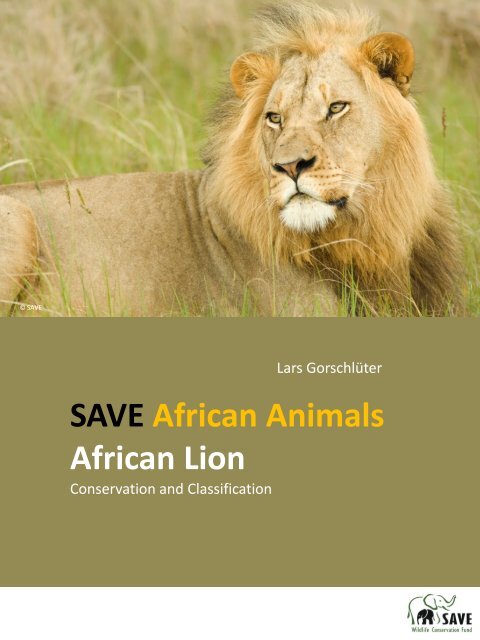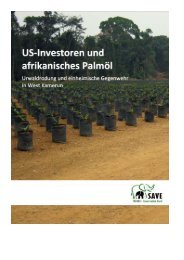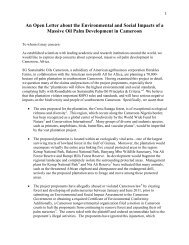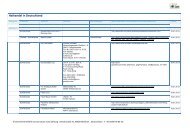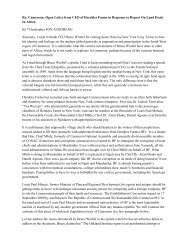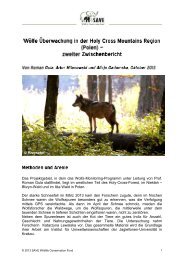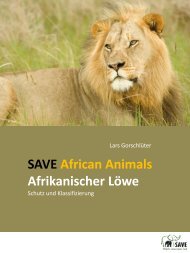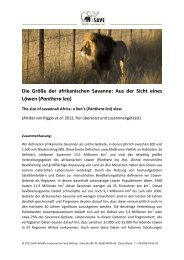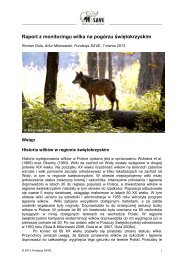African Lion
African Lion - SAVE Wildlife Conservation Fund
African Lion - SAVE Wildlife Conservation Fund
- No tags were found...
Create successful ePaper yourself
Turn your PDF publications into a flip-book with our unique Google optimized e-Paper software.
© SAVE<br />
Lars Gorschlüter<br />
SAVE <strong>African</strong> Animals<br />
<strong>African</strong> <strong>Lion</strong><br />
Conservation and Classification
<strong>African</strong> Predators<br />
Carnivores belong to the family of mammals. The term “carnivora” was derived from the Latin<br />
caro, carnis (meat) and vorare (V). However, not all carnivores live off of meat. Ecologists describe<br />
a predator as being an organism that consumes the whole or parts of other living organisms.<br />
Hence, their prey is still alive at the time of consumption. That is why herbivores, carnivores and<br />
parasites all belong to the same family of predators.<br />
© SAVE<br />
Carnivores have a highly important ecological function, as, by hunting prey, they prevent certain<br />
kinds from multiplying too much, which could otherwise harm certain vegetations and endanger the<br />
stabilization of the ecosystem. Predators are also referred to as ecological key stone species or<br />
umbrella species because of their particular preference in food, but also because of their size and<br />
their low psycho-logical tolerance regarding environmental fluctuations.<br />
Hence, their important ecological role makes predators quite valuable and worthy of protection. If<br />
they are protected so are multitudes of other species. With that said, predators are one of various<br />
sensitive indicators that account for the health of an eco system’s welfare.<br />
An important reason for the decline of many natural inhibited wildlife populations (especially<br />
carnivores) is the conflict between wild animals and humans. Even in our project’s region of<br />
central Kalahari, such a conflict is present. The need for more land among the population has<br />
steadily increased, which, in turn, has brought a growing pressure on wild animal habitats.
Conservation of <strong>African</strong> <strong>Lion</strong>s (Panthera leo)<br />
Throughout the <strong>African</strong> continent large predators such as the lion are<br />
under serious threat due to fragmented landscapes, low densities and the<br />
inevitable conflict with people for space and resources.<br />
Protected areas such as national parks or privately owned conservancies<br />
therefore remain critical for their conservation. However, there is<br />
increasing evidence that even within protected areas where carnivores<br />
should thrive, the type of anthropogenic influence determines the<br />
survival of the species.<br />
IUCN (International Union for Conservation of Nature)<br />
Classification: Grade of endangerment: 3 – slightly endangered<br />
© SAVE
<strong>Lion</strong>s<br />
Characteristics<br />
<strong>Lion</strong>s are the king of the jungle. They have a massive build and abundant strength. They can weigh up to 250 kilo; reach a<br />
body length of more than three meters and a shoulder height of up to one meter; and are said to be ten times stronger<br />
than any human being. It only takes one stroke of the paw for a lion to break the necks of their prey.<br />
Hence, it is no surprise that the lion is found on so many crests, seals and flags, as it stands for power and dignity.<br />
Findings show that the first lion species lived over 1.75 million years ago.<br />
A typical characteristic is the illustrious lion mane. It takes up to five years for it to grow to its fullest splendor. The mane<br />
serves as protection to the male in battles with other animals. For this reason, the female lioness does not have a mane.<br />
Moreover, it would be more of a handicap, as the females are entrusted with hunting and breeding. To a further extent,<br />
studies show that male lions living in colder regions tend to have a fuller mane than those that are found in warmer<br />
climates. Thus, they serve as a protection against the cold.<br />
A lion’s age can be calculated by the gradual discoloration of their teeth, called Melanism. They can live up to 20 years.<br />
Another famous feature is the tassel at the tip of a lion’s tail. The tassel conceals a rudimentary spine.<br />
© SAVE © SAVE<br />
Habitat<br />
Today, lions are found mostly south of the Sahara in the vast<br />
Plains Of West and East Africa.<br />
They have been extinct in North Africa since the 1940’s, became<br />
Highly endangered this past century in Asia and only a few<br />
hundred reside presently at Gir-Nationalpark in India.
© SAVE<br />
Social Behavior<br />
<strong>Lion</strong>s are group animals. They are social wild cats and said to be one of the most intelligent animals. They are not as clean<br />
as house cats, as they only tend to clean the bridge of their nose regularly. However, cross-cleaning does occur in extreme<br />
cases.<br />
<strong>Lion</strong>s live and hunt in prides of up to 30 other cats. The work distribution is well-defined among the animals. Prides can live<br />
in territories that range to 400 squared kilometers. They mark their territory by spraying their urine. Males are busy<br />
defending their territory while females care for the cubs and prey. Usually, a pride consists of about three males and<br />
related females with their cubs. The males are the head of the hierarchy. The hierarchy is sustained even when it comes to<br />
consuming prey: first, the males eat, then the females and last, the cubs. Typically, if the young cubs are of the pride male,<br />
they precede the females. A male lion can devour up to 20 kilos of meat per meal. A lion’s roar serves as a defense<br />
mechanism and can be heard up to 8 kilometers away.<br />
<strong>Lion</strong>s hardly have any natural enemies because of their known strength. Only hyenas must be defeated occasionally<br />
because of the food rivalry between these two species, which has existed since primeval times. Saber tooth cats, for<br />
example, an extinct wildcat line, often left at least half of their game for hyenas, mostly because back then, they had<br />
undeveloped teeth that did not allow a full consumption. Hence, only the lion breed with the shorter teeth survived, which,<br />
in turn, resulted in the extinction of the referred to type of hyena. Thus, through evolution, a new type of hyena evolved<br />
that had to fight the lions for food from then on. Usually the lions win the fights and kill the hyenas. However, they never<br />
eat them. Battles among a pride occur for the sake of the hierarchy. It is rare that they result in death. Yet, if a male<br />
„outsider“ tries to take over the pride a violent power struggle does arise. In the event that the intruder wins the fight, all<br />
the pride’s cubs are killed. This way, the female lions are willing to mate quicker so the new pride leader can spread his<br />
genes. This insemination process can take up to four months.<br />
If the inferior loser happens to survive the battle it becomes a nomad and must forever fend for itself. Though usually it<br />
dies due to the effects of the brawl. Male lions tend to lead a pride for an average of 2-3 years, before a younger, stronger<br />
single male banishes or kills them. Some are even able to reign over two prides at the same time. On the contrary, females<br />
usually stay associated with the same pack their whole lives. Young males must leave their pride when they have reached<br />
their third year of birth. These single lions, known as nomadic males, graze through the plains until they are sexually<br />
mature, which is around the age of five. Frequently, two or more nomadic males will form their own association and take<br />
on new territories and their females. This is crucial to the lion species, as this way, they are able to intermix their genes.<br />
There is a 90% chance that a pride takeover is successful when there are three nomadic lions involved. The quota for one<br />
nomad to succeed is only 1:6. Naturally, single males favor weaker coalition partners, as to increase the chances of<br />
spreading their own genes.
Diet<br />
<strong>Lion</strong>s hunt in groups. They prefer hunting in the morning or at night. They wait in ambush, encircle the prey, and then take<br />
it down by using their claws to attack. The act of striking usually results in a tear of the prey’s aorta. Hence, it bleeds to<br />
death. Most often, lions attack antelopes, gnus, buffalo and zebras, but in the national parks of Botswana they even hunt<br />
young elephants and hippopotami.<br />
First, the mouth is eaten, intestines and organs follow. <strong>Lion</strong>s also enjoy eating the entrails of ruminants, as they are highly<br />
rich in vitamins. Whoever is initially at the kill and begins eating first claims primacy. However, lions do eat collectively.<br />
Unlike leopards they will eat carrion. In fact, they account for 1/7th of a lion’s diet. An adult wildcat will typically eat up to<br />
20 animals a year.<br />
© SAVE<br />
Reproduction<br />
Female lions become sexually mature between the age of three or four years. Males can smell the hormone odor females<br />
spread when they are in estrus. That is how they know it is mating season. For this purpose, males have a specific organ<br />
called the "Jacobson-Organ", which is found in the lion’s palate. The male cat pulls its upper-lip back and opens its mouth<br />
in oder to perceive the lioness’ hormone level. However, it can not mate with a female if she is not willing to. Willingness<br />
is projected when a lioness lays down on her stomach, thereby allowing the male to mount her. Females are generally in<br />
heat for five days. During this time copulations take place up to 40 times a day. The actual ovulation does not occur until<br />
after mating. If the male happens to be reproductively weak the female will seek a different mating partner.<br />
Breeding cycles can depend on the amount of prey. Often females of a pride breed synchronously. This serves to raise the<br />
cubs’ chance of survival, as there are no older cubs that eat the younger ones food. <strong>Lion</strong> offspring are blind the first two<br />
weeks after birth. They are nursed for 6 months and aren’t weaned from their mother until after a year. They weigh about<br />
two kilos when they are born. As a result of food shortage, negligence and the takeover of power by other males, only<br />
20% of lion cubs live to experience more than 2 years of life. 27% of all cubs die from the hierarchy invasion of another<br />
male lion. In order to increase the survival rate of a cub and to protect them from hunters, the females relocate to<br />
different hiding places every three to four days. During this process, they hold their cubs so they can not be traced. <strong>Lion</strong><br />
cubs are not just nursed by their mothers, they are raised collectively. After about six months the young lions begin to eat<br />
meat.<br />
When they are four months old they join their mother for the first time on a hunt and watch and learn. They do not fully<br />
master their hunting skills until they are two years old. They can not roar until then either.
Enemies<br />
According to the IUCN (International Union for Conservation of Nature) there has been a 50 % decline of the lion<br />
population in the past 30 years. Some experts even speak of a 90% reduction. Fact is, whereas in 1980, there were an<br />
estimated 250,000 lions, today they only number 20-30,000. The IUCN has red-listed them by giving them the rank of a<br />
"threatened species" (rank three). The cause for their level of endangerment is man, as lion hunting has always been a<br />
favorite past time to humans.<br />
Reasons for a lion’s threatened species status<br />
1. Trophy Hunting<br />
Roughly, since the beginning of man time, humans have been hunting<br />
for lions. Today's vast hunting industry is proof enough. It is norm for<br />
hunters to hunt male lions. Overall, a total of 4-5000 lions are bred so<br />
man can hunt. Often, hunting farms offer lion killings for 16,000 dollars.<br />
Apart from the decline in lion population, the hunt for male lions also<br />
results in a constant change of pride leader. When the head of a pride<br />
dies, a nomad usually takes over and kills the cubs. Such a chain of<br />
effects occurs in such short intervals that consequently, the death rate<br />
of cubs increases to 70%. Female lions may kill offspring that is not<br />
from a pride leader as well. Thus, a young lion’s chance of survival<br />
increases when a nomad coalition seizes a pride.<br />
2. Confrontation with farmers<br />
Time and again, farmers kill lions out of protection for their herds.<br />
Naturally, such farm herds are easy prey to lions that have wandered<br />
out of the parks or their territory to find food. In addition, lions are<br />
easily lured away beyond their borders when their prey is in search of<br />
water. However, there are many projects and ways that can prevent<br />
lions from killing farmer’s herds. But unfortunately, farmers usually<br />
choose the easy way out and simply shoot the predators.<br />
Although they do get compensated by the government for their loss,<br />
there are regulations that are difficult to fulfill. The farmers must be<br />
able to prove that animals are missing and were killed by wild cats.<br />
Other ways of prevention are driving the herds into stables at night (lions are night active), 24 hour supervision by dogs<br />
(studies have shown that lions tend to avoid watch dogs), or erecting pens to keep the lions out and the herds in.<br />
Furthermore, wildlife parks could move nomad lions to more remote parks, as the nomads seem to be the ones that<br />
keep wandering back to the same farmyards. Additional solutions to avoid lion-wandering are to build water reservoirs<br />
and provide enough prey in the wildlife parks.<br />
Fact is, we must find a way to ensure the survival of this species, despite man. And the first most important measures to<br />
take are to raise awareness and approach the matter professionally.
3. Diseases such as LLF and the FIV Virus (Feline Immunodeficiency Virus)<br />
A dramatic problem among the wild cat populations since 1995 are the diseases LLF and FIV. Especially in the<br />
southern part of Kruger National Park in South Africa, tuberculosis and the FIV virus have taken their toll on lions. To<br />
this date, there is no vaccine for these diseases.<br />
Tuberculosis, which affects the digestive tract, is transmitted to lions through the eating of buffalo, which are virus<br />
carriers through domestic cattle. <strong>Lion</strong>s with tuberculosis lose so much weight in such a short period of time that<br />
among other things, they are prone to more illnesses such as the FI Virus. Hence, mortality rates go up. Almost 90 %<br />
of the lions living in Kruger National Park have this bacterial infection. In 1962, it was an epidemic of biting house flies<br />
that killed many wild cats. As a result, a genetic shift took place, reducing the genetic diversity drastically.<br />
Most likely, the bacteria and viruses are originally brought to Africa by domestic dogs. 1000 lions died in the Serengeti<br />
in 1994 because of dogs that carried them. However, since house dogs can not survive in wildlife parks, there must be<br />
an animal that acts as an agent. Many study cases were performed and discoveries were made that 96% of all lions<br />
have an anti-body for the Feline-Herpes-Virus. 42% have an immune complex for the Feline-Immune- Deficiency-Virus<br />
and 26% have one for the Canine-Distemper-Virus. Furthermore, experts found that the viruses in Botswana and<br />
Tanzania form their own sub type. In Tanzania, it is said that the animals were infected by the Fi-virus much earlier<br />
than it broke out. Similar to the Human Immunodeficiency Virus, it can take up to four years for an outbreak to occur.<br />
In cases as such, it is most likely that jackals are the agent. A way to determine the rate of infestation faster and more<br />
efficiently would be affordable urine tests.<br />
A simple vaccination for house-held dogs alone would protect from such infectious diseases. Unfortunately, although<br />
several of these vaccinations are on the market, they are usually not enforced. Beyond that, a better control and a<br />
registration of dogs would also be a productive attempt. A different approach would be to genetically mix the lions<br />
from Kenya and South Africa.<br />
Obviously, there is still much to be done when it comes to calling attention to the problem, educating and actually<br />
implementing solutions.<br />
© SAVE
© SAVE<br />
250.000<br />
200.000<br />
150.000<br />
100.000<br />
50.000<br />
-<br />
1975 1990 2002 2006<br />
© SAVE<br />
Figure 1: Shows the estimated population and the decline over the last 30-35 years.<br />
Picture: <strong>Lion</strong> darting , Kalahari, Botswana.<br />
In Africa, lions (Panthera leo) are on a rapid decline. From an estimated number of 200,000 <strong>African</strong><br />
lions in 1975 (Myers, 1975), less than 100,000 remained by the early 1990s (Nowell & Jackson, 1996)<br />
and current population estimates range from as low as 23,000 (Bauer & van der Merwe, 2004) to<br />
39,000 (Chardonnet, 2002). The most recent, and probably most accurate, estimate numbers the<br />
continent-wide lion population at less than 28,000 (IUCN/SSC Cat Specialist Group, 2006).<br />
Key publications:<br />
Bauer, H., van der Merwe, S. (2004) Inventory of free-ranging lions (Panthera leo) in Africa. Oryx, 38:26-31<br />
Chardonnet, P. (2002) Conservation of the <strong>African</strong> lion. International Foundation for the Conservation of Wildlife and Conservation Force, Paris<br />
IUCN SSC Cat Specialist Group (2006). Regional Conservation Strategy for the lion Panthera leo in Eastern and Southern Africa. IUCN SSC Cat Specialist<br />
Group, Gland, Switzerland<br />
Myers, N. (1975) The silent savannas. International Wildlife, 5:5-10<br />
Nowell, K., Jackson, P. (eds) (1996) Wild cats: status survey and conservation action plan. IUCN, Gland
© SAVE


